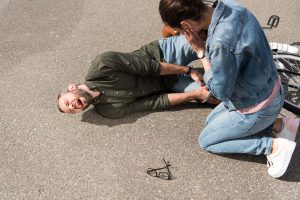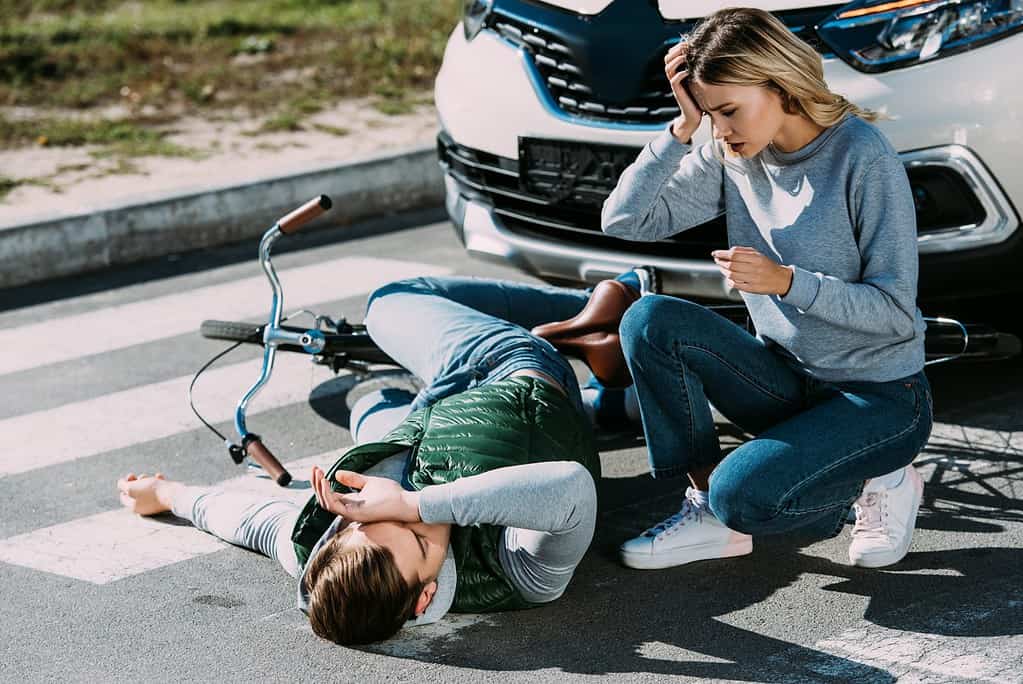Riding a motorcycle is more fun than driving a car- but far more dangerous. Motorcyclists lack adequate protection except for their helmets and other wearable gear.
So, they are incredibly vulnerable to injury in the case of an accident. You can never talk of fender benders as far as a motorcycle is concerned.
In 2019, approximately 5,000 riders lost their lives, and more than 84,000 injured in accidents. If you look at miles traveled, riders are 29 times likely to die in a crash than someone in a passenger car.
The question is, where do these accidents occur? Does the type of road increase the risk of a motorcycle accident?
This post discusses everything you need to know about motorcycle street accidents including key statistics.
What Are the Statistics of Motorcycle Accidents on a Street?
The NHTSA crash stats data report for 2019 provides vital information on motorcycle accidents on the street. Here are the statistics:
- 55% of fatal motorcycle crashes happen between motorcycles and other vehicles on the street.
- Two-thirds of motorcycle crashes with other vehicles are the other driver’s fault.
- 61% of fatal motorcycles occur in urban areas and 39% in rural areas, suggesting that highways are safer than street roads.
- 76% of fatal motorcycle accidents were head-on collisions while 7% were rear-ended.
- 41% of fatal accidents involved a motorcycle going straight when another auto hits them when turning left.
- 87% of fatal motorcycle accidents happen on non-highway roads.
Where Do Motorcycle Fatalities Typically Happen?
Based on the NHTSA crash stats data, 61% of fatal motorcycle accidents occurred in urban areas in 2019, while 39% occurred on rural roads. That suggests that highways are much safer.
However, only 34% of fatal collisions occurred at intersections. 66% happened at non-intersection, indicating that highways could be more dangerous.
We need to take a closer look to get a clearer picture. The Federal Highway Administration describes six types of roads that constitute highways and non-highways.
- Interstates
- Non-interstate freeways and expressways
- Non-interstate principal artery roads (urban and rural roads that are not highways)
- Non-interstate minor arterial roads
- Non-interstate collectors (roads connecting arteries and local roads)
- Non-interstate local roads

Only roads in the first two categories are highways. And the cumulative percentage of fatalities on highways is 13% (9% on interstates and 4% on non-interstate highways).
87% of fatalities occur on the remaining roads. That is to say, the majority of deaths occur on regular streets. The most dangerous of the six categories is principle arterial roads, which account for 29% of all motorcycle fatalities.
What Makes Highways Safer than Streets?
The average speed on the streets is relatively lower than on the highway. So how then are highways safer for motorcycle riders than city streets?
Well, though it seems stranger at a glance, an analysis of motorcycle accidents on the highway vs. street can explain why.
- You know that fatal accidents are mostly head-on collisions. But highways have separated traffic flow, usually with barriers between the opposite lanes.
- Connectors and merging lanes have better visibility and appropriate signage. This reduces the risk of side collisions with vehicles coming into or exiting the highway.
- Unlike the stop-and-go traffic on street roads, highway traffic flows steadily and unpredictably. As a result, there are trivial variations in average speed of vehicles.
- Highways have more lanes than other roads, allowing all autos (motorcycles included) enough space to overturn and avoid accidents.
What Causes Motorcycle Accidents on Streets?
So, what causes motorcycle accidents on streets? Here are some of the leading causes:
1. Cars Making Left-Hand Turns
Collisions between motorcycles and cars making left-hand turns are prevalent on the street and are often fatal. In 2019, almost half of all fatal accidents involving a car and a motorcycle happened when the car took a left turn.
Cars turning left usually hit passing motorcycles in intersections because of driver distraction, low visibility, or speeding.
2. Collisions
Collisions are the number 1 cause of street motorcycle accidents on streets. According to the 2019 NHTSA data, about half of the 5,114 fatal motorcycle accidents involved another moving car.

In three-quarters of these crashes, the vehicle hit the motorbike from the front side. Only 7% were rear-ended accidents.
Head-on collisions are the most dangerous accidents for motorcyclists due to the high impact involved and because motorcycles lack safety features.
3. Not Wearing a Helmet
The easiest way to safeguard yourself when riding a motorbike is to wear a helmet. Yet, most riders ignore wearing it.
The NTSA approximates that 33 out of every 100 motorcyclists killed in accidents could have survived if they had worn a helmet.
4. Speeding
Light and powerful motorbikes encourage speeding and other risky behavior. In 2019, 33 percent of motorcyclists involved in fatal accidents were speeding!
Younger motorcyclists are more likely to be involved in fatal accidents while speeding.
5. Road Hazards
Street roads tend to have uneven surfaces, gravel, railway tracks, and other road hazards. While a car driver may not notice this, a motorcycle rider has to be careful of such.

Motorcycles are not as stable as cars so any irregularities and objects on the street can cause an accident. In fact, even fallen leaves on a street can topple a bike off and cause a crash.
What Does Insurance Do About Motorcycle Accidents on a Street?
When you are involved in a motorcycle accident on the street, you start thinking of how to seek compensation for your injuries from your insurance company.
So, when you file a personal injury claim, the first thing insurance companies do is to determine fault in the accident. The insurance adjuster evaluates the following pieces of information to find out who (or what) caused the motorcycle crash:
- The police report
- Witness testimonies
- Surveillance camera footage
- Photos of the accident scene, your motorcycle, and injuries
- Reports from law enforcement officers and accident reconstruction specialists
The insurance adjuster looks into all this to build a case against you as the motorcyclist, which will justify denying your claim or offering a reduced settlement.
Strategies like this can be highly costly for motorcycle accident victims who count on receiving fair compensation for their injuries. But if you get an experienced motorcycle accident lawyer, your case will not be derailed by the insurance adjuster.
What Injuries Likely Result from Motorcycle Accidents on a Street?
Motorcycle accidents on the street result in fatal injuries. Any body part can sustain injuries in the event of a crash, even at low speeds.
Here are the most common injuries that result from motorcycle accidents on the streets.
a) Traumatic Brain Injuries (TBI)
The NHTSA conducted a study involving 104,472 motorcycle riders who’ve once suffered injuries in traffic accidents. The researchers found that 15% of riders suffered TBI from a motorcycle accident when using a helmet.

On the other hand, 21% suffered injuries without a helmet. Within the whole group, TBI accounted for 54% of motorcyclists who did not survive.
b) Fractures
Fractures occur very often after motorcycle accidents on the streets. You are especially more vulnerable to fractures on pelvic and wrist bones.
Here is how fractures occur- during a crash, you attempt to use your hands to shield your face. So, your hands literally bear impact the crash, which exposes you to lower extremities. You may suffer fractures on the hip or pelvic as a result.
c) Road Rash
A road rash injury can happen when you land on the pavement during an accident.
If your costume is not thick enough, the pavement may tear your clothes and scratch your skin. This will result in skin abrasions, otherwise known as road rash.

Road rash is highly disposed to infections and permanent scarring, so you need medical treatment immediately.
d) Spinal Injuries
Trauma to the spinal column causes severe injuries for riders. Such injuries as torn ligaments, herniated discs, and spinal cord damage are widespread in motorcycle accidents.
Any form of trauma to the spinal cord may lead to temporary or even permanent paralysis.
e) Internal Injuries
In case of blunt-force trauma during a motorcycle accident on the street, your internal organs can be hurt and lead to internal bleeding.
Internal injuries can also result when a sharp object penetrates your skin during a crash- this is what we call penetration trauma.
f) Biker’s Arm
As earlier mentioned, you use your hands to break the fall when thrown off the motorbike during a crash. This can hurt your arm and also cause permanent nerve damage, known as a biker’s arm.

Luckily, you can reduce your risk of a biker’s arm injury by wearing a leather jacket and elbow pads.
Contact an Experienced Motorcycle Accident Lawyer Today
Highways might be safer than city streets when you’re using a motorcycle, but that doesn’t mean they are safe.
Remember, motorcyclists are always at risk on busy roads, especially from negligent drivers who don’t look out for others.
Besides, most insurance companies are biased against motorcycle riders and blame them for crashes. If you or your loved one is a motorcycle accident victim on the street and the insurance company denies your claim, we can help you.
At Legal Giant, we have experienced motorcycle accident injury attorneys who will help and guide you throughout the claims process.
Contact us for a free, no-obligation consultation today.

